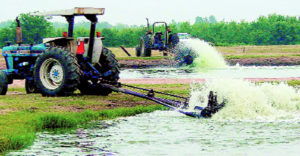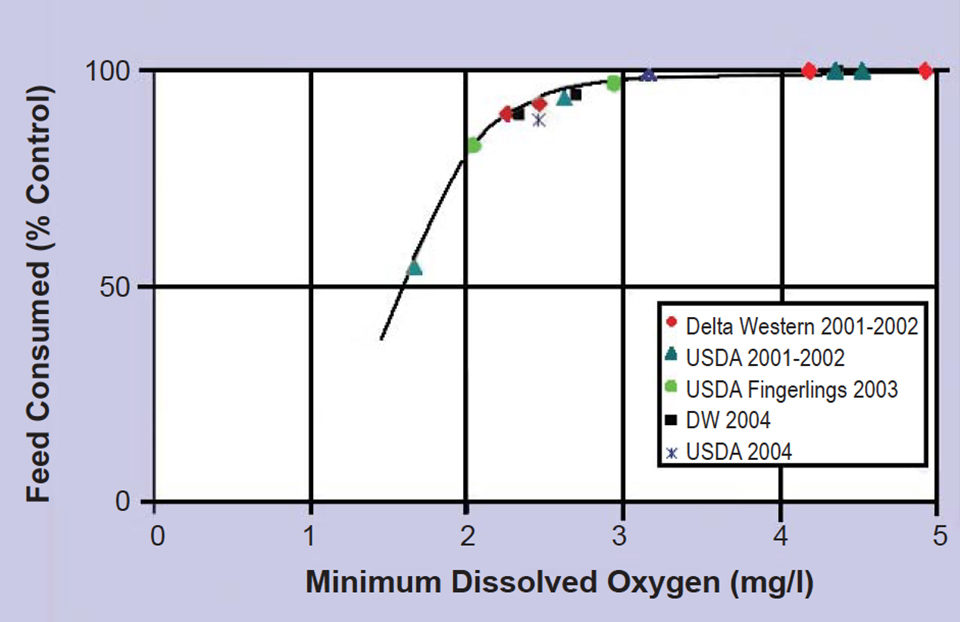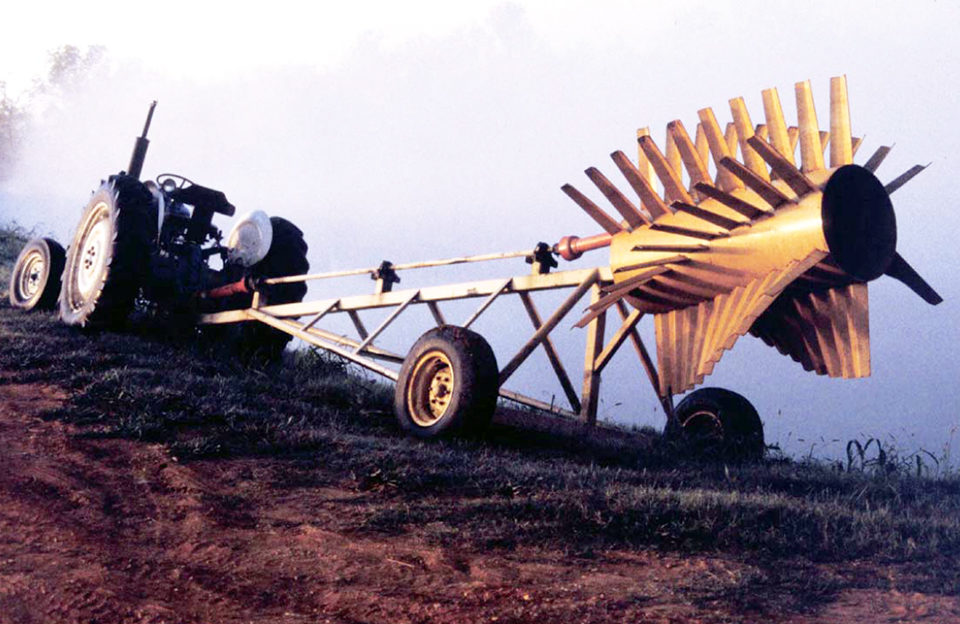Oxygen has not yet been economically used for routine catfish pond oxygen management

Increased aeration is arguably the single greatest factor responsible for the steady increase in catfish production rates seen in the past 40 years. Prior to emergency aeration, feed input was limited to 35 to 45 kilograms per hectare per day and production rarely exceeded 1.7 metric tons (MT) per hectare (ha) per year. At this low feeding rate, fish kills caused by low dissolved oxygen (D.O.) occurred only rarely.
Emergency aeration with tractor-powered paddlewheels and pumps during infrequent low oxygen events allowed farmers to increase feeding and stocking rates, and production doubled. As production intensity increased to the point that emergency aeration was used in most ponds on a nightly basis, electric aerators permanently installed in the ponds became economical.
Intensifying catfish production through increased aeration also conserves land for other uses. In 2004, 286,000 MT of food-size catfish were produced by U.S. farmers in 57,142 ha of ponds. To reach that figure using the best available technology without aeration would require almost 170,000 ha. Much of the land no longer required for catfish culture is in wetland reserve and other conservation or habitat management programs.
Increased production
A variety of aerators have been developed and used over the years, but the United States catfish industry has come to rely almost entirely on 10-hp electric paddlewheels for routine aeration, and tractor-powered paddlewheels and “sidewinders” for back-up emergency aeration. The industry average is approaching 4.9 horsepower per hectare for routine aeration, with some farms using up to 7.4 horsepower per hectare. Gross yields under the more intensive oxygen management range 6.7 to 13.4 MT per hectare.
Even higher production rates may be possible – some commercial farmers have used up to 11.8 horsepower per hectare in smaller ponds and reportedly achieved yields approaching 22.0 MT per hectare. Greater increases in production may be achieved with further increases in aeration, but the practicality of this will be determined by economics on a case-by-case basis.
Dissolved oxygen
While increases in fish production with increased aeration may be an accepted principle, the optimum D.O. concentration for catfish production has long been a matter of speculation. Catfish farmers have historically used fish behavior to determine the need for aeration. As long as catfish did not exhibit visible oxygen stress, it was felt the D.O. was acceptable. Most extension publications and aquaculture texts recommend aerating at D.O. concentrations of 3.0 to 4.0 milligrams per liter. Recent research indicates that neither of these beliefs is entirely accurate.
In seven pond studies (Fig. 1) in which the lowest morning D.O. concentrations were maintained at a specified level, the effects on food consumption, growth, and production were compared to a high-D.O. control. Results showed that the optimum practical range for morning D.O. should be 1.5 to 2.5 milligrams per liter. Maintaining D.O. above 3.0 milligrams per liter was neither biologically nor economically beneficial.

Significant (5 to 10 percent) decreases in various production parameters were seen when D.O. concentrations decreased to 2.5 milligrams per liter. When the D.O. was allowed to fall daily to 1.5 milligrams per liter, a relatively high concentration by current commercial standards, food consumption fell by 45 percent, average fish weight decreased by 31 percent, and net production dropped 54 percent.
While the morning minimum DO concentration should be maintained at 1.5 to 2.5 milligrams per liter, aerators should be turned on before the D.O. drops that low. In large ponds with multiple aerators, in which D.O. concentrations can vary over 10 milligrams per liter from one end to the other, the first aerator should be turned on when the D.O. concentration drops to 4.0 to 5.0 milligrams per liter. While aeration is not necessary at that level, the first aerator mixes the pond and establishes a current to which the fish orient.
Other aerators are then turned on in sequence if the D.O. concentration falls further. Tractor-powered aerators are used if the electric aerators are not able to maintain dissolved oxygen in the desired range.
Automation

Pond oxygen-monitoring and control systems become economical at higher aeration rates. When multiple aerators are used in each pond, control systems can result in potential cost savings on power usage by more efficiently turning aerators on and off in a timely manner.
While these systems do not replace human oxygen checkers, they do provide a valuable back-up when producing catfish at high intensity. The systems can operate routine aeration on most of the ponds, while the oxygen checker (who can have access to farmwide data via radio link) responds to problems. Checkers manually check D.O. concentrations at additional locations in trouble ponds, reset tripped electrical breakers, and move tractors to provide emergency aeration where needed.
Oxygen checkers can also observe, note, and respond to fish behavior, which automation cannot yet do. Automated systems can, however, prevent fish loss due to oxygen depletion at times when routine oxygen monitoring does not occur.
Aerator placement
Little research has been done with respect to aerator placement in catfish ponds. Catfish fry and fingerlings do not move great distances toward aerators during low-oxygen events, so farmers typically disperse aeration in those ponds.
Since catfish stockers and food fish will move to an aerator as D.O. drops, most farmers group multiple aerators together in production ponds. This also allows a sidewinder to be used in conjunction with the electric aerators to maintain a single zone of aerated water to which the fish move.
Aerators positioned in the middle of the long sides of ponds have been shown to be the most efficient at mixing the entire pond. However, location of power lines, cost of extra gravel for side levees, and convenience of operation usually are determining factors in aerator placement.
Research recently conducted on paddlewheel placement in 10, 6.9-ha commercial ponds indicated the traditional method of aerator placement (maximizing pond mixing) may not be the best in large ponds. Ponds in which aerators were positioned to circulate and aerate water within about 25 percent of the pond area had higher morning D.O. concentrations and better production parameters than ponds in which the paddlewheels mixed the entire pond. While the differences were not statistically significant, this study indicated that new thinking on aerator placement may be justified.
Liquid oxygen
Liquid oxygen has been used to aerate intensive aquaculture systems raising species other than catfish. With liquid oxygen, it is possible to maintain much higher D.O. concentrations than with splash-type surface aerators such as paddlewheels.
Small production systems with high animal densities have capitalized on this. The catfish industry has not. With relatively low fish densities and the huge acreage involved, oxygen has not yet been economically used for routine catfish pond oxygen management.
It has been used successfully at commercial operations to increase oxygen while catfish are held overnight prior to delivery to the processor. While the transfer efficiency through the diffusers used is low (15 percent), the high risk, value of the crop, and short-term duration justify the use.
Replacing tractors and side-winders for emergency aeration will likely be the next use of liquid oxygen on commercial catfish farms. At higher fish production rates, liquid oxygen could have potential for routine aeration with the development of technology to increase transfer efficiency.
(Editor’s Note: This article was originally published in the December 2005 print edition of the Global Aquaculture Advocate.)
Now that you've finished reading the article ...
… we hope you’ll consider supporting our mission to document the evolution of the global aquaculture industry and share our vast network of contributors’ expansive knowledge every week.
By becoming a Global Seafood Alliance member, you’re ensuring that all of the pre-competitive work we do through member benefits, resources and events can continue. Individual membership costs just $50 a year. GSA individual and corporate members receive complimentary access to a series of GOAL virtual events beginning in April. Join now.
Not a GSA member? Join us.
Author
-
Eugene L. Torrans
USDA ARS Catfish Genetics Research Unit
Thad Cochran National Warmwater Aquaculture Center
P.O. Box 38
Stoneville, Mississippi 38776 USA[118,111,103,46,97,100,115,117,46,115,114,97,64,115,110,97,114,114,111,116,108]
Tagged With
Related Posts

Responsibility
Appraising pond liners for shrimp culture
The use of plastic-lined ponds by shrimp farmers can significantly improve production efficiency, support more production cycles per year, and higher mechanical aeration rates and stocking densities. The capital cost of lining ponds can be very significant, so a thorough feasibility analysis is recommended when considering this production tool.

Responsibility
Does Coriolis force impact aerator placement in aquaculture ponds?
The Coriolis effect has no bearing on aerator placement and aquaculture pond management. The most important consideration with mechanical aeration is to provide a sufficient amount to maintain adequate dissolved oxygen concentration.

Health & Welfare
Dissolved oxygen dynamics
Dissolved oxygen management is the most important requirement of aquaculture pond water quality. DO concentration below 3 mg/L is stressful to shrimp.

Responsibility
Electrical conductivity of water, part 1
The electrical conductivity of water, usually called specific conductance or simply conductivity, is an important property of water frequently measured in aquaculture systems, and provides an assessment of the total concentration of dissolved ions in water.


